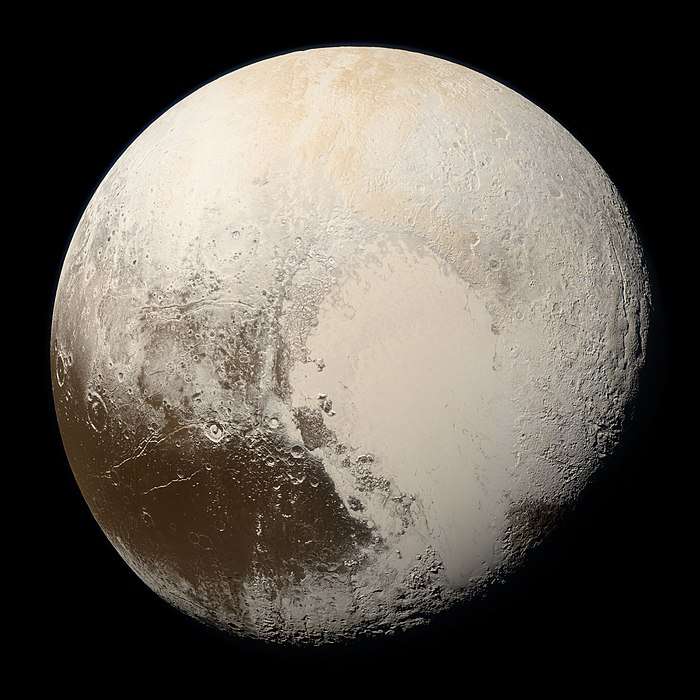2010 RF43
2010 RF43 is a trans-Neptunian object of the scattered disc orbiting in the outermost regions of the Solar System. It measures approximately 650 kilometers (400 mi) in diameter and is a strong dwarf-planet candidate. The object was first observed on 9 September 2010, by American astronomers David Rabinowitz, Megan Schwamb and Suzanne Tourtellotte at ESO's La Silla Observatory in northern Chile.[1]
| Discovery [1][2] | |
|---|---|
| Discovered by | D. L. Rabinowitz M. Schwamb S. Tourtellotte |
| Discovery site | La Silla Obs. |
| Discovery date | 6 September 2010 (first observed only) |
| Designations | |
| 2010 RF43 | |
| TNO [3] · SDO [4][5] p-DP [6] · distant [1] | |
| Orbital characteristics [3] | |
| Epoch 23 March 2018 (JD 2458200.5) | |
| Uncertainty parameter 4 | |
| Observation arc | 4.90 yr (1,789 days) |
| Aphelion | 61.726 AU |
| Perihelion | 37.127 AU |
| 49.426 AU | |
| Eccentricity | 0.2489 |
| 347.49 yr (126,922 d) | |
| 96.362° | |
| 0° 0m 10.08s / day | |
| Inclination | 30.702° |
| 25.199° | |
| 192.38° | |
| Physical characteristics | |
Mean diameter | 636.06 km (estimate)[7] 643 km (estimate)[6] ≈735 km (estimate)[5] |
| 0.09 (assumed)[5] 0.10 (assumed)[7] 0.11 (assumed)[6] | |
| 3.7[3] · 4.0[6] · 4.1[7] | |
Orbit and classification
2010 RF43 orbits the Sun at a distance of 37.1–61.7 AU once every 347 years and 6 months (126,922 days; semi-major axis of 49.4 AU). Its orbit has an eccentricity of 0.25 and an inclination of 31° with respect to the ecliptic.[3] The body's observation arc begins with its official first observation at La Silla in September 2010.[1]
Due to its relatively high eccentricity and inclination, it is an object of the scattered disc rather than one of the regular Kuiper belt. Its perihelion of 37.1 AU is also too low to make it a detached object, which typically stay above 40 AU and never come close to the orbit of Neptune. The Minor Planet Center, however, does not list it among the scattered-disk objects,[8] but rather among the trans-Neptunian objects of the Kuiper belt.[2]
Physical characteristics
Diameter and albedo
Based on an absolute magnitude of 3.7,[3] and an assumed albedo of 0.09, the Johnston's archive estimates a mean-diameter of approximately 806 kilometers (501 mi),[5] while astronomer Michael Brown assumes an albedo of 0.11 and calculates a diameter of 643 kilometers (400 mi) using a fainter magnitude of 4.0. Brown also characterizes the object as a "highly likely dwarf planet", the second-highest level in his classification scheme (also see list of candidates).[6]
The Collaborative Asteroid Lightcurve Link assumes an albedo of 0.10 and calculates a diameter of 636 kilometers (395 mi) based on an absolute magnitude of 4.1.[7]
Rotation period
As of 2018, no rotational lightcurve of this object has been obtained from photometric observations. The object's rotation period, pole and shape remain unknown.[3][7]
Numbering and naming
As of 2018, this minor planet has not been numbered or named.[1]
References
- "2010 RF43". Minor Planet Center. Retrieved 23 February 2018.
- "List Of Transneptunian Objects". Minor Planet Center. Retrieved 23 February 2018.
- "JPL Small-Body Database Browser: (2010 RF43)" (2015-07-31 last obs.). Jet Propulsion Laboratory. Retrieved 23 February 2018.
- Buie, Marc W. "Orbit Fit and Astrometric record for 10RF43". SwRI (Space Science Department). Retrieved 23 February 2018.
- Johnston, Wm. Robert (30 December 2017). "List of Known Trans-Neptunian Objects". Johnston's Archive. Retrieved 23 February 2018.
- Brown, Michael E. "How many dwarf planets are there in the outer solar system?". California Institute of Technology. Retrieved 23 February 2018.
- "LCDB Data for (2010+RF43)". Asteroid Lightcurve Database (LCDB). Retrieved 23 February 2018.
- "List Of Centaurs and Scattered-Disk Objects". Minor Planet Center. Retrieved 23 February 2018.
External links
- MPEC 2011-U09 : 2010 RF43, Minor Planet Electronic Circular, 17 October 2011
- 2010 RF43 at AstDyS-2, Asteroids—Dynamic Site
- 2010 RF43 at the JPL Small-Body Database

_(cropped).jpg)
